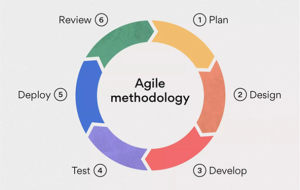19 Chapter 19 – Problems and Plans
Managing problems and plans
In today’s flat organizations with fewer hierarchical levels, employees are more involved in identifying and resolving problems and managing complex projects. People react differently when faced with problem solving and planning tasks. Some want to jump straight into action, while others assume that everyone is on the same page after an initial meeting. These strategies may work with simple problems and well-established teams, but they can also lead to details being missed and creative solutions being overlooked. Common pitfalls of inadequately structured problem-solving or project management include:
- Without well-defined goals, teams struggle to stay focused and aligned. A shared framework ensures everyone understands the objectives and works towards the same outcomes.
- When team members are unsure of their roles and goal, it leads to confusion and tasks falling through the cracks. A shared framework assigns accountability, ensuring everyone knows the desired outcome, their duties, and deadlines.
- A framework for planning ensures everything starts with an understanding of the desired outcome and the roles and actions needed to get there.
- Miscommunication or lack of communication can result in misunderstandings, duplicated efforts, and missed deadlines. A structured approach promotes regular updates and clear information-sharing channels.
- Inconsistent methods to tackle tasks can create confusion and inefficiency. A shared framework standardizes processes, making coordination and quality maintenance easier.
- Ineffective resource management causes bottlenecks and delays. A structured approach helps in planning and distributing resources more efficiently.
 Have you ever been on a team that struggled to stay on track? Problem-solving and planning frameworks can make a big difference. These tools help teams coordinate more effectively by clarifying everyone’s thinking, speeding up progress, and improving communication. They create a shared understanding of what needs to be done and how to do it.
Have you ever been on a team that struggled to stay on track? Problem-solving and planning frameworks can make a big difference. These tools help teams coordinate more effectively by clarifying everyone’s thinking, speeding up progress, and improving communication. They create a shared understanding of what needs to be done and how to do it.
Structured problem-solving usually involves steps like clarifying the problem, analyzing its root causes, brainstorming solutions, getting feedback, and testing ideas. Using a problem-solving system not only helps you and your team tackle issues more confidently, but also makes it easier to communicate your progress to your supervisors when completing your part independently.
Project management is about setting clear goals and milestones, anticipating risks, and measuring success to see where improvements can be made. By keeping communication organized and clear, project management ensures that everyone is working towards the same objectives and that the project runs smoothly.
Knowing and using problem-solving and project management frameworks enhance a person’s sense of agency. These structured models provide a shared approach to tackling tasks and challenges, empowering you to take control of your work, express influence, and make thoughtful decisions. Problem-solving and planning naturally integrate with and enhance the principles of all three mindsets.
Problem-solving and planning fit with an agentic mindset by empowering individuals to take initiative, make informed decisions, and shape their environment. These skills align with a growth mindset by encouraging continuous learning, adaptation, and improvement through reflection and feedback. They also complement a relational mindset by helping to set the stage for open communication, collaboration, and the co-creation of shared understanding.
Framework to think about it
Two well-known problem-solving frameworks are the Deming Cycle (PDSA) and the Six Thinking Hats. Let’s dig into these now to give you a framework for thinking about problem solving and planning.
The PDSA Cycle (Plan-Do-Study-Act)
This is a systematic process designed for continuous improvement of a product, process, event, or service. Here are the four steps:
- Plan: Start with a a) clear goal, b) a well-thought-out theory to guide your actions, and c) success metrics to measure progress.
- Do: Implement your plan.
- Study: Monitor outcomes to assess the effectiveness and validity of your plan and theories. Identify what’s working and what needs improvement.
- Act: Make necessary adjustments, refine methods, and expand successful practices on a larger scale.
Notice how this approach mirrors the experiential learning cycle, which involves learning through reflection on doing. The experiential learning cycle consists of four stages:
- Concrete Experience: Engaging in an activity or task.
- Reflective Observation: Reflecting on the experience and observing outcomes.
- Abstract Conceptualization: Drawing conclusions and forming theories based on the reflection.
- Active Experimentation: Applying the new theories to the next set of actions, leading to new experiences.
This approach fosters critical thinking, systematic problem solving, and an attitude of continuous improvement. This framework will contribute to your sense of agency, your ability to communicate clearly with others, and your potential for influence on organizational structures and outcomes.
Six Thinking Hats
 Now let’s turn to the Six Thinking Hats. Developed by Edward de Bono, it is a creative thinking and problem-solving framework that encourages looking at a problem from multiple perspectives. The “hats” are metaphorical and represent different modes of thinking:
Now let’s turn to the Six Thinking Hats. Developed by Edward de Bono, it is a creative thinking and problem-solving framework that encourages looking at a problem from multiple perspectives. The “hats” are metaphorical and represent different modes of thinking:
- White Hat: Focuses on facts, data, and information. Asks: What do we know? What do we need to know?
- Red Hat: Represents emotions and intuition. Asks: What are our gut feelings and emotional reactions?
- Black Hat: Involves critical judgment and caution. Asks: What are the potential problems and risks?
- Yellow Hat: Stands for optimism and positive thinking. Asks: What are the benefits and opportunities?
- Green Hat: Emphasizes creativity and new ideas. Asks: What are the alternatives and possibilities?
- Blue Hat: Concerned with process control and organization. Asks: What is the next step? How should we manage the thinking process?
The Six Thinking Hats method is a great way to make sure decisions are well-rounded and based on thorough analysis. It helps bring out different viewpoints, which leads to better understanding and fewer conflicts among team members. You can use it to guide team discussions or even to organize your own thoughts when tackling problems on your own.
We will now turn to two project management frameworks, the Critical Chain Method and Agile Methodology.
Critical Chain Method
 Critical Chain Method (CCM)
Critical Chain Method (CCM)
Critical Chain Method is a project management technique that focuses on both task dependencies and buffers. It has some complexities that are best sourced outside of this book, but we will cover the principles below:
Critical Path: Start by identifying the longest sequence of large dependent tasks essential for completing your project. As an example, imagine you are planning a work party. You must: Decide on a theme, send out party invites, find a venue, and host the event.
Feeding Chain: Then determine paths of activities that merge into the critical path. Building on the example above, you need to decide who to invite and collect their contact information (before sending invites), and purchase decorations, and decorate the venue (before hosting the event).
Buffers: The plan buffers, which are extra resources, or time added, to ensure smooth project progress. Project Buffers: Extra time before the project’s final deadline. Feeding Buffers: Extra time between feeding chain tasks and critical path tasks. Resource Buffers: Extra resources like additional team members or equipment.
Steps to Use CCM:
- Identify the Critical Path: Determine essential tasks then determine the feeding chain.
- Determine Resource Needs: Estimate required resources.
- Place Buffers: Add extra time or resources for uncertainties.
Even if you don’t fully implement CCM, you can still benefit from these principles. This helps you organize yourself, communicate, and influence others.
Agile Methodology
 Agile is a very different approach than CCM. It is a popular way of completing projects in today’s workplace. It focuses on delivering small, functional pieces of work quickly and continuously improving them based on feedback, rather than waiting to deliver a large project at the end. Agile originated from approaches developed in the 1980s and gained popularity in 2001 in the tech world. Today, Agile principles are used not only in software development, but also in marketing, and other industries. Even if your team or work doesn’t specifically follow Agile methodology, you can still benefit from its principles and practices.
Agile is a very different approach than CCM. It is a popular way of completing projects in today’s workplace. It focuses on delivering small, functional pieces of work quickly and continuously improving them based on feedback, rather than waiting to deliver a large project at the end. Agile originated from approaches developed in the 1980s and gained popularity in 2001 in the tech world. Today, Agile principles are used not only in software development, but also in marketing, and other industries. Even if your team or work doesn’t specifically follow Agile methodology, you can still benefit from its principles and practices.
The Agile approach to project management encourages simplicity, feedback, and time efficiency. There are a few different Agile systems but something they all have in common is the following:
- You are encouraged to focus on creating what is truly important rather than complicating deliverables.
- It breaks a project into smaller chunks that you can share, test, and add value with quickly rather than waiting for some large result (that may or may not hit the mark).
- This allows for regular feedback from stakeholders and the ability to make adjustments.
- This method also advocates for periodically reviewing what went well and what could be improved in the product development and team process.
Understanding problem-solving and project management frameworks enhances your sense of agency and improves communication and coordination within a team. These frameworks help create a shared understanding of goals and processes, which is essential for effective collaboration. As you develop these skills, remember the importance of self-awareness, trust, collaboration, managing tensions, and a willingness to understand and respect the differences that make each team unique.
Application
Problem-solving and project planning skills empower employees to not just passively adapt to the organization, but actively shape their roles within it. Hierarchical structures can influence who gets to make decisions and how resources are allocated, potentially stifling innovation and problem resolution at lower levels. Power dynamics can affect whose ideas are heard and valued during problem-solving sessions, while management styles can either foster a collaborative environment or create silos. Additionally, group norms and roles can either facilitate or hinder effective coordination and communication among team members.
Structured approaches to problem-solving and project management enhance your ability to communicate effectively and assert your influence in the workplace.
These frameworks provide a common language and clear steps that guide everyone involved, reducing misunderstandings and ensuring that all team members are aligned in their goals and expectations. When you use these frameworks, you take control of the process, allowing you to proactively address issues, clarify roles, and streamline communication. This boosts your agency, empowering you to shape outcomes and make more informed, strategic decisions.
Problem-solving and project management frameworks also address fundamental human needs for autonomy, competence, and relatedness. By applying these frameworks, you gain a greater sense of autonomy as you navigate complex tasks with a clear plan in mind. Your competence is enhanced as you become more skilled at breaking down problems and managing projects systematically. Additionally, by improving communication and collaboration through these frameworks, you strengthen your sense of relatedness, building stronger connections with your team and contributing to a supportive, cohesive work environment. Adopting structured problem-solving and project management techniques enables aspirational communication
Here are some key steps to help you enhance your problem-solving and project management skills:
- Adopt Structured Frameworks: Use established frameworks helps you define the outcomes you want and approach problems methodically.
- Promote Clear Communication: Establish clear communication channels to ensure that all team members are informed and engaged.
- Define Goals, Roles, and Responsibilities: Clearly outline the desired outcome, roles and responsibilities of each team member to avoid confusion and ensure accountability.
- Encourage Collaborative Decision-Making: Foster a culture of collaboration where team members feel valued and are encouraged to contribute their ideas.
- Reflect and Improve: Regularly review the outcomes of problem-solving efforts and project progress.
By integrating these practices into your daily work, you can enhance your ability to navigate organizational structures effectively and support aspirational communication.
Reflection
Reflect on the intrinsic power of problem solving and project management to act as a transformative force within an organization. Consider how structured approaches to identifying and resolving issues can influence and reshape organizational structures, such as power dynamics, hierarchies, and cultural norms. Think about how effective problem-solving and project management can enhance team cohesion, efficiency, and overall organizational effectiveness. Reflect on how these skills can shape individual and collective identities, fostering a sense of agency, purpose, and shared achievement within your team and organization.
Reflect on the personal impact of your history and choices related to problem solving and project management. How have your past experiences with tackling complex tasks shaped your current approach? Consider how your problem-solving style and project management practices influence your interactions with colleagues and your overall work environment. How do your choices in structuring and managing tasks reflect your values and aspirations? Think about how your approach to these skills supports the kind of professional identity you aspire to build. How does your problem-solving and project management style impact your confidence and sense of agency?
Identify actionable steps and strategies to strengthen your problem-solving and project management skills. How can you address any knowledge and action gaps you’ve identified? What immediate steps can you take to improve your effectiveness in these areas? Consider ways to refine your approach to ensure ongoing growth and adaptability. How can you continuously assess and enhance your problem-solving and project management practices to support both your personal development and the success of your organization?
Supplementary Readings
EPM. (2022, February 4). PDCA cycle explained. YouTube. https://www.youtube.com/watch?v=bO3GpAjVvD8
Litmos Heroes. (2014, December 9). What is six thinking hats?. YouTube. https://www.youtube.com/watch?v=UZ8vF8HRWE4
Wrike. (2021, July 8). What is critical project management?. YouTube. https://www.youtube.com/watch?v=WTYec73hpN0
Simlilearn. (2022, September 6). What is agile methodology? Introduction to agile methodology in six minutes. YouTube. https://www.youtube.com/watch?v=8eVXTyIZ1Hs
